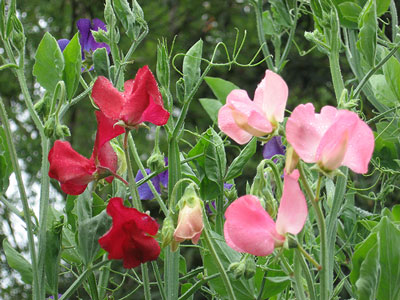From the Magazine: November 2014

Enchanting, ruffled, fragrant sweet peas have been cultivated by gardeners for centuries. Photo by Mary Wilhite.
by Mary Wilhite
Delightful Sweet Peas
The lovely, old-fashioned annual remains forever young
The delicious, sweet scent and fluttery blossoms of annual sweet peas make them popular garden flowers. For centuries, gardeners have cultivated and cut sweet peas, enjoying their long-lasting beauty and intoxicating fragrance in bouquets. The many colors of the petals and their delicate beauty give sweet peas a vintage charm, whether growing in the garden or bunched in a fresh arrangement.
What a long, strange trip it’s been*
Sweet peas have a lengthy horticultural history. The first record of them was written by Francisco Cupani, a Franciscan monk, in 1695. Amazingly, seeds are available today from this original variety, a maroon and purple bicolor with a heady fragrance, bearing the name ‘Cupani’.
With the introduction of new varieties with longer stems and larger and more colorful flowers, sweet peas enjoyed celebrity status in England in the early 20th century. The equivalent of modern fan clubs cropped up and societies formed to grow, show and judge these popular flowers.
Today, sweet peas are considered old fashioned, but I predict a modern renaissance for these delightful flowers. With their carefree nature and perfume redolent of orange and honey, more gardeners will be drawn to their charm.
Sweet blossom come on*
Growing sweet peas in the South is tricky, but well worth the effort. The key to success is proper seed preparation and timing. The small seeds need scarifying – a way to break the hard outer covering of the seeds. This can be done with sandpaper, or nicking the seeds with a blade. Both of these options are difficult, if not dangerous, with small seeds. I have found soaking the seeds overnight in warm water helps loosen the seed coating.
Sweet peas like cool temperatures and need to be well established before the weather warms up in late spring. We find starting the seeds from November through January gives the plants a good start before the arrival of summer heat. Plant your soaked seeds directly into the ground during these months, or start them indoors in a cool location. A heated greenhouse will pamper them too much, and like a spoiled child, they will not flourish on their own after this sheltered beginning.
Sow the seeds in a sunny location in loose, rich soil. Add organic matter to the soil before planting for best flower production. Bone meal added to the soil is believed to keep the stems long. Water your vines during dry periods. They will germinate in a few weeks’ time, sending up a few sets of leaves. Then they put their energy into growing roots, so for the next few weeks you won’t see much top growth. Normal low temperatures in Texas during the winter usually don’t faze the emerging vines. If we have unseasonably cold temperatures, say down in the 20s for an extended period, cover your little seedlings with frost cloth or leaves to protect them.
Once the weather starts to warm up in February, sweet peas really start to shoot up. Flexible stems put out two sets of leaves and two sets of tendrils between lengths of bare stem. The tendrils catch and twine around anything smaller than the diameter of a pencil, so they are easy to train on a trellis or fence.
Do not fertilize your sweet peas too much or you will have lush green foliage and few flowers. Provide afternoon shade when the weather heats up in late spring.
She’s got everything delightful*
Sweet peas make excellent cut flowers. Long bare stems topped with ruffled blooms are easy to harvest and arrange in a vase. The multi-colored flowers have a sweet fragrance. Cut off the vines regularly to keep them producing fresh new flowers. Once the flowers shrivel on the vine, the plants put all their energy into seed production.
Try some of these varieties to start your love affair with sweet peas:
Cupid or Sweetheart – Compact varieties perfect for growing in window boxes or hanging baskets.
‘Elegance’ Series – Bred in America for cut-flower production, these plants have very long stems and extra large flowers.
‘Streamer Mix’ – Very large flowers in a mix of orange, blue, pink, purple and red, all streaked with white. The fragrance is exceptional.
* Lines from Grateful Dead songs; lyrics by Robert Hunter and Bob Weir.

